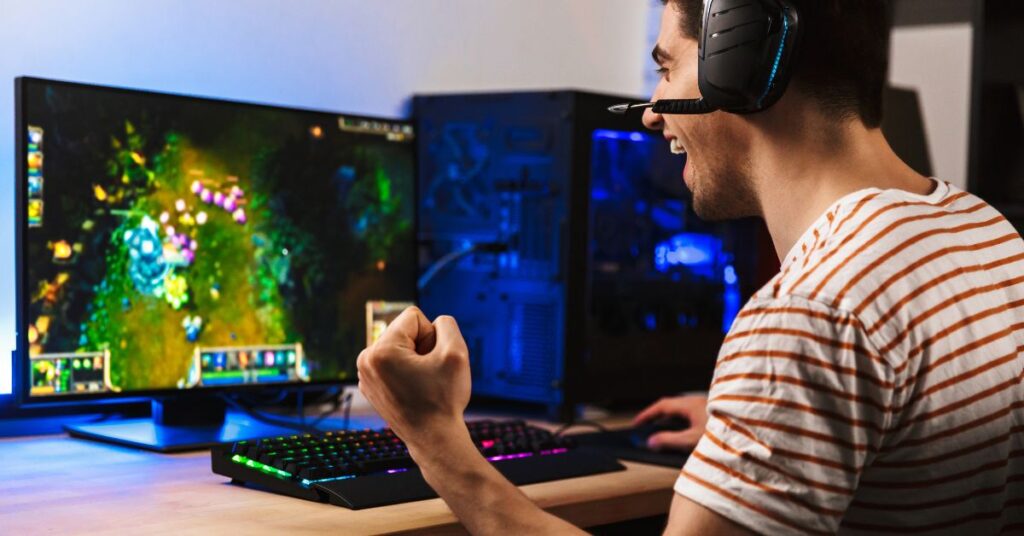The digital entertainment industry is expanding rapidly, and two terms that are often used interchangeably are gaming and esports. Although both are related to the fascinating world of video games, they offer distinct experiences. Therefore, it is essential to comprehend the differences between gaming and esports in these two areas to navigate the constantly evolving realm of virtual competition and enjoyment.
This blog post will explore the differences between gaming and esports. From the level of competition to the motivation behind the play, we’ll uncover the unique characteristics that define each. Whether you’re a seasoned gamer or a curious newcomer, this exploration will equip you with the knowledge to appreciate the diverse spectrum of digital entertainment.
Defining the Terms of Gaming and Esports
Gaming
The term “gaming” contains a vast and diverse landscape of activities centered around the interactive world of video games. Whether exploring expansive virtual worlds, conquering challenging puzzles, or simply unwinding with a casual mobile title, gaming offers a unique blend of entertainment, escapism, and social connection.

Motivations for Gaming
For most gamers, the primary motivation lies in the sheer enjoyment and satisfaction derived from the experience. Whether it’s the thrill of mastering a difficult level, the camaraderie of playing with friends online, or simply the opportunity to relax and unwind after a long day, gaming provides an escape from the mundane. It allows players to indulge in their passions.
Gaming is not only a source of entertainment but also helps build a sense of community and belongingness among players. Online gaming platforms and communities connect players from all walks of life, allowing them to forge friendships, share strategies, and participate in collaborative activities.
Non-Competitive Nature
While some games contain competitive elements, it’s important to recognize that most gaming activities are inherently non-competitive. Players can approach games at their own pace, set goals, and explore the virtual world autonomously. This non-competitive environment allows gamers to enjoy the experience at their level without the pressure of winning or performing at a high level.
Esports
In contrast to casual gaming, esports are organized and competitive, with dedicated players, structured leagues and tournaments, and a thriving spectator scene.

Professionalization of Esports
Esports have witnessed a remarkable surge in recent years, evolving from a niche activity into a globally recognized phenomenon. Today, professional esports players compete in dedicated leagues and tournaments, vying for substantial prize pools and attracting massive audiences. This professionalization has created a competitive ecosystem where players dedicate themselves to rigorous training regimens and strategic planning, similar to athletes in traditional sports.
Spectator Aspect
One of the defining characteristics of esports is the presence of a dedicated and enthusiastic spectator base. Just like fans of traditional sports, esports enthusiasts tune in to watch professional players compete in high-stakes matches, cheering for their favorite teams and witnessing exceptional displays of skill and strategy. This spectator element greatly contributes to the growth and popularity of esports, transforming it into a cultural phenomenon that transcends the boundaries of gaming.
Key Differences Between Gaming and Esports

Competitive Focus
The most basic difference between gaming and esports is their competitive approach. While gaming can certainly involve elements of competition, most activities are inherently casual and informal. Players often set goals and compete against friends or AI opponents in a relaxed, non-threatening environment.
Esports are known for their focus on competition. Players train hard and participate in organized leagues and tournaments with significant prize pools, seeking professional recognition. The skill level required to compete in esports is much higher, demanding strategic thinking, exceptional hand-eye coordination, and unwavering mental strength.
Organization and Structure
Another key difference lies in the organization and structure of each activity. Gaming activities are typically unstructured and spontaneous, appearing individually or in small groups. Players can choose their games, set their own rules, and engage in collaborative or competitive play according to their preferences.
Esports, on the other hand, operate within a highly structured environment. Established leagues, tournaments, and teams provide a framework for competitive play, with clear rules and regulations governing everything from game selection to player conduct. This structure ensures fairness, fosters professionalism, and elevates esports to a legitimacy comparable to traditional sports.
Motivation
The motivations for participating in gaming and esports differ significantly. For most gamers, the primary motivator is pure enjoyment. They enjoy exploring virtual worlds, conquering challenges, and simply having fun. Social interaction also plays a significant role, as online communities enable players to connect with friends and build meaningful relationships.
Esports players, however, are driven by a different set of motivations. They are primarily motivated by the thrill of competition, the desire for recognition and validation, and the potential for financial rewards. The competitive environment of esports provides them with a platform to showcase their skills, test their limits, and ultimately achieve a sense of accomplishment through victory.
Spectator Interest
While some popular games attract a dedicated audience of viewers, the primary focus of gaming remains on the player experience. The emphasis is on individual enjoyment, personal challenge, and social interaction.
Esports, on the other hand, have a flourishing audience that enjoys watching the games being played. Millions of viewers tune in to watch professional players compete in high-stakes matches, similar to fans of traditional sports.
This passionate audience fuels the growth of esports, generating revenue through sponsorships, advertising, and merchandise sales. The spectator aspect contributes significantly to the overall success and popularity of esports, transforming it into a cultural phenomenon with a global reach.
Similarities Between Gaming and Esports
Despite their differences, it is important to recognize the strong connection between gaming and esports.

Esports as a Subset of Gaming
It’s crucial to recognize that esports are not separate from the broader gaming community; they represent a highly focused and organized subset of that community. Most esports players are also passionate gamers who enjoy playing for leisure and recreation. Their participation in competitive tournaments stems from their love for the game, desire to test their skills, and ambition to contribute to advancing their chosen titles.
Shared Skill Development
Both gaming and esports develop valuable skills at different levels of intensity. Players at all levels hone their hand-eye coordination, problem-solving abilities, and strategic thinking. Esports players, in particular, develop exceptional reflexes, mental stamina, and the ability to collaborate effectively with teammates in high-pressure environments.
Competitive Gaming Communities
The rise of esports has significantly impacted the gaming culture, promoting the growth of dedicated competitive communities around specific titles. These communities provide a platform for aspiring players to connect with like-minded individuals, share strategies, participate in amateur tournaments, and aim for improvement. This environment promotes a sense of belonging, camaraderie, and a shared passion for the competitive aspect of gaming.
Influencing Game Design and Development
The growing popularity of esports has also influenced the design and development of modern video games. Developers are increasingly incorporating features and mechanics specifically tailored towards competitive play, catering to the needs and expectations of the esports community. This feedback loop between professional players, game developers, and the broader gaming community contributes to the constant evolution and improvement of video games, creating a more engaging and rewarding experience for all players.
The Future of Gaming and Esports
The gaming and esports landscapes are constantly evolving, fueled by technological advancements, changing consumer preferences, and the ever-expanding reach of the internet. As we look towards the future, several exciting possibilities and challenges emerge.

Technological Advancements
Emerging technologies like Virtual Reality (VR) and Augmented Reality (AR) are poised to revolutionize gaming and esports. VR offers immersive experiences that transport players into the heart of virtual worlds, while AR overlays digital elements onto the real world, creating a hybrid experience.
These technologies have the potential to blur the lines between entertainment and reality further, creating even deeper levels of engagement for players and spectators alike.
Impact on Education and Entertainment
Esports are increasingly being recognized as a legitimate form of entertainment and competition. This recognition leads to integrating esports into educational programs, which can be used to develop students’ teamwork, strategic thinking, and problem-solving skills.
Additionally, the growing popularity of esports as a spectator sport is creating new opportunities for content creators, broadcasters, and event organizers.
Challenges and Opportunities
Despite the exciting possibilities, gaming, and esports face challenges as they move forward. Issues such as addiction, online harassment, and the monetization of virtual goods require careful consideration and responsible solutions. Additionally, ensuring inclusivity and accessibility for players of all backgrounds will be crucial for sustained growth and development.
Speculations on the Future
We expect further integration between gaming and esports, with more titles incorporating competitive elements and fostering a thriving amateur scene. The rise of cloud gaming and streaming platforms will make gaming more accessible to a wider audience, potentially leading to a global esports audience reaching over a billion viewers in the coming years.
The gaming and esports industries have a bright future with countless possibilities. By embracing technological advancements, tackling challenges responsibly, and promoting diversity and inclusivity, these industries can rise to new levels and establish themselves as a major force in the global entertainment landscape.
Conclusion
The lines dividing gaming and esports are fading, creating an exciting and dynamic community for players and fans alike. While their focus, structure, and motivations differ, both share a foundation of shared skills, dedication, and passion. With emerging technologies like VR and AR, the future of gaming and esports promises immersive experiences that transcend the boundaries of the screen.




